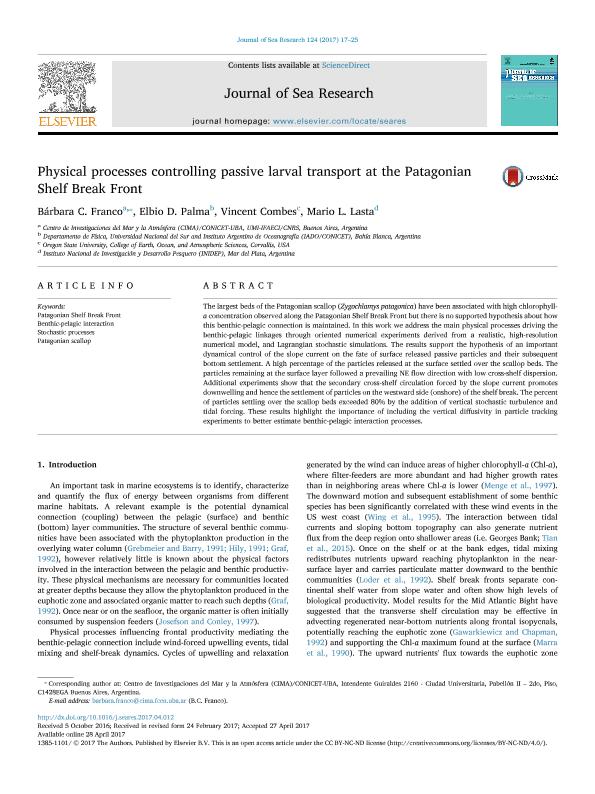Mostrar el registro sencillo del ítem
dc.contributor.author
Franco, Barbara Cristie

dc.contributor.author
Palma, Elbio Daniel

dc.contributor.author
Combes, Vincent
dc.contributor.author
Lasta, Mario L.
dc.date.available
2018-09-07T18:43:47Z
dc.date.issued
2017-06
dc.identifier.citation
Franco, Barbara Cristie; Palma, Elbio Daniel; Combes, Vincent; Lasta, Mario L.; Physical processes controlling passive larval transport at the Patagonian Shelf Break Front; Elsevier Science; Journal of Sea Research; 124; 6-2017; 17-25
dc.identifier.issn
1385-1101
dc.identifier.uri
http://hdl.handle.net/11336/58779
dc.description.abstract
The largest beds of the Patagonian scallop (Zygochlamys patagonica) have been associated with high chlorophyll-a concentration observed along the Patagonian Shelf Break Front but there is no supported hypothesis about how this benthic-pelagic connection is maintained. In this work we address the main physical processes driving the benthic-pelagic linkages through oriented numerical experiments derived from a realistic, high-resolution numerical model, and Lagrangian stochastic simulations. The results support the hypothesis of an important dynamical control of the slope current on the fate of surface released passive particles and their subsequent bottom settlement. A high percentage of the particles released at the surface settled over the scallop beds. The particles remaining at the surface layer followed a prevailing NE flow direction with low cross-shelf dispersion. Additional experiments show that the secondary cross-shelf circulation forced by the slope current promotes downwelling and hence the settlement of particles on the westward side (onshore) of the shelf break. The percent of particles settling over the scallop beds exceeded 80% by the addition of vertical stochastic turbulence and tidal forcing. These results highlight the importance of including the vertical diffusivity in particle tracking experiments to better estimate benthic-pelagic interaction processes.
dc.format
application/pdf
dc.language.iso
eng
dc.publisher
Elsevier Science

dc.rights
info:eu-repo/semantics/openAccess
dc.rights.uri
https://creativecommons.org/licenses/by-nc-nd/2.5/ar/
dc.subject
Benthic-Pelagic Interaction
dc.subject
Patagonian Scallop
dc.subject
Patagonian Shelf Break Front
dc.subject
Stochastic Processes
dc.subject.classification
Meteorología y Ciencias Atmosféricas

dc.subject.classification
Ciencias de la Tierra y relacionadas con el Medio Ambiente

dc.subject.classification
CIENCIAS NATURALES Y EXACTAS

dc.title
Physical processes controlling passive larval transport at the Patagonian Shelf Break Front
dc.type
info:eu-repo/semantics/article
dc.type
info:ar-repo/semantics/artículo
dc.type
info:eu-repo/semantics/publishedVersion
dc.date.updated
2018-09-07T13:44:13Z
dc.journal.volume
124
dc.journal.pagination
17-25
dc.journal.pais
Países Bajos

dc.journal.ciudad
Amsterdam
dc.description.fil
Fil: Franco, Barbara Cristie. Consejo Nacional de Investigaciones Científicas y Técnicas. Oficina de Coordinación Administrativa Ciudad Universitaria. Centro de Investigaciones del Mar y la Atmósfera. Universidad de Buenos Aires. Facultad de Ciencias Exactas y Naturales. Centro de Investigaciones del Mar y la Atmósfera; Argentina
dc.description.fil
Fil: Palma, Elbio Daniel. Consejo Nacional de Investigaciones Científicas y Técnicas. Centro Científico Tecnológico Conicet - Bahía Blanca. Instituto Argentino de Oceanografía. Universidad Nacional del Sur. Instituto Argentino de Oceanografía; Argentina. Universidad Nacional del Sur. Departamento de Física; Argentina
dc.description.fil
Fil: Combes, Vincent. State University of Oregon; Estados Unidos
dc.description.fil
Fil: Lasta, Mario L.. Instituto Nacional de Investigaciones y Desarrollo Pesquero; Argentina
dc.journal.title
Journal of Sea Research

dc.relation.alternativeid
info:eu-repo/semantics/altIdentifier/doi/https://dx.doi.org/10.1016/j.seares.2017.04.012
dc.relation.alternativeid
info:eu-repo/semantics/altIdentifier/url/https://www.sciencedirect.com/science/article/pii/S1385110116302520
Archivos asociados
